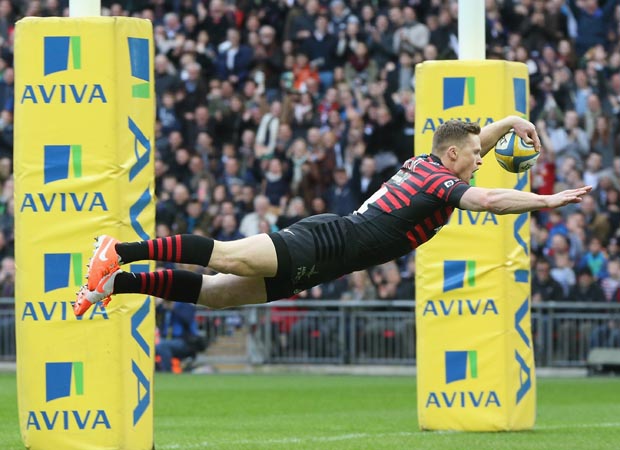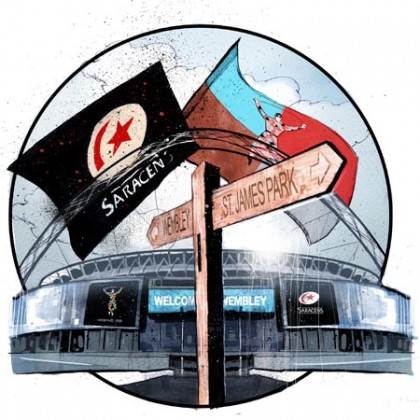 If anyone had had the temerity to suggest 20 years ago that a game between Saracens and Harlequins would set a world record attendance for a club fixture of 83,889, as happened last weekend at Wembley, they would have been told they were in cloud cuckoo land.
If anyone had had the temerity to suggest 20 years ago that a game between Saracens and Harlequins would set a world record attendance for a club fixture of 83,889, as happened last weekend at Wembley, they would have been told they were in cloud cuckoo land.
You can understand why. At that time a Sarries home game on the municipal ground at ramshackle Bramley Road would attract 2,000 spectators at most, about 150 of whom could squeeze into the tiny covered stand on one side of the pitch. The Stoop was an improvement on that, albeit marginal.
Yet, the achievement of Edward Griffiths, the Saracens chief executive, and his marketing team in creating the conditions to attract such a huge live audience for a standard Premiership fixture has barely had a mention. It has been treated as if it is a PR stunt more than a remarkable landmark for English club rugby.
My view that it is a milestone in the pro era for which Griffiths and company deserve rich plaudits, and it was reinforced this week when word filtered through that the Wembley showpiece had seen Saracens turn a £450,000 profit.
This contrasts favourably with Saracens first record crowd (83,761) at the stadium for the same fixture two years ago, and for events like the Harlequins ‘Big Game' and the Wasps ‘Stinger', both of which attract crowds of between 50,000 and 75,000 to Twickenham. The difference being that on those occasions tickets have been available at such a reduced rate that the host club does little more than break even.
However, the beauty of these annual event matches is that they have demonstrated clearly that rugby is capable of reaching a wider audience as long as it is prepared to add a modicum American Football-style marketing savvy, including other attractions – such as ‘A' list bands and musicians – to the central rugby showpiece.
Griffiths believes Saracens have developed an annual event model that all Premiership clubs could borrow from to spread the rugby word in their region of the country. “There is no reason that Newcastle Falcons could not do the same thing at St James Park – and we would be very happy to share the information we have with other clubs for the benefit of the game as a whole.”
 Griffiths has a proven track record of turning unpromising situations into credit, with the most notable being a seminal contribution to the creation of the ‘Rainbow Nation' feel-good factor around the 1995 World Cup in South Africa. At the time, Griffiths was the South African Rugby Union's newly appointed chief executive, and he knew that promoting unity – one team, one country – was crucial to the success not only of the World Cup, but also in supporting peaceful transition in a deeply divided country.
Griffiths has a proven track record of turning unpromising situations into credit, with the most notable being a seminal contribution to the creation of the ‘Rainbow Nation' feel-good factor around the 1995 World Cup in South Africa. At the time, Griffiths was the South African Rugby Union's newly appointed chief executive, and he knew that promoting unity – one team, one country – was crucial to the success not only of the World Cup, but also in supporting peaceful transition in a deeply divided country.
Griffiths, who has also been a journalist and broadcaster, says of the Wembley extravaganza: “It's not done overnight. We've been at Wembley for four years and that's our 11th game there. Our board is now reaping the reward after being persistent.”
He explains, “You need to create a calendar event. Previously we tried to do it in a ten-week period, and you can't do that. Crowds come when you can offer them a really good family day out – it doesn't matter if they are diehard Saracens fans, our aim is to take it to a wider audience, and people around the world are aware now of a really big club rugby event in London.”
He adds, “We have been helped by Premiership Rugby being able to confirm fixtures nine months in advance because for an annual event you need a reasonable run-in period in which to sell tickets and provide entertainment, with artists singing songs people know, so that it all becomes a bit of fun.”
Griffiths reveals a whole panoply of marketing tools to move tickets which were priced at £60 on or around the halfway line at Wembley, and in the upper tier at £20 for adults and £7 for juniors. He says there were numerous discount schemes also offered through the likes of Group On and Wowcher selling £20 tickets at £14, as well as cashback deals for partner clubs of Saracens.
He also points to the importance of the entertainment element with choirs and cheerleaders, not least because family and friends supporting them might account for another 3,000 tickets.
However, Griffiths says that it requires dedication as well as perseverance. “In Field of Dreams, Kevin Costner hears a voice saying, ‘Build it and he will come'. Well, that's not our experience. It's been bloody hard work, and we've built the crowd block by block almost.” Griffiths' testimony that a club with Saracens heavyweight financial resources have reached the promised land for their Wembley calendar event only after many years of hard toil should also serve notice to Premiership Rugby that their minimum standards criteria for promoted clubs are indefensible.
Despite Sarries' Wembley breakthrough many Premiership clubs are still struggling to attract spectators. Newcastle's last home attendance was 7,073 against Leicester, and Sale's last weekend against Northampton fewer than 6,000.
Demanding that newly-promoted clubs have a 10,000 seater stadium when almost half the existing clubs in the top league habitually attract attendances 3,000 lower than that is ring-fencing.
The Premiership should allow a promoted club time to build a stadium and a crowd – and hire Griffiths as a roving consultant to help them, and the league as a whole, to grow the game.


























